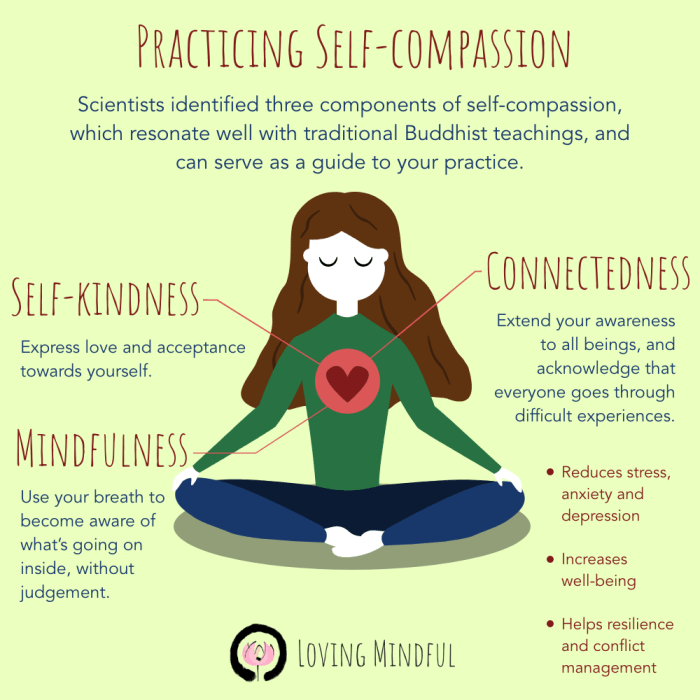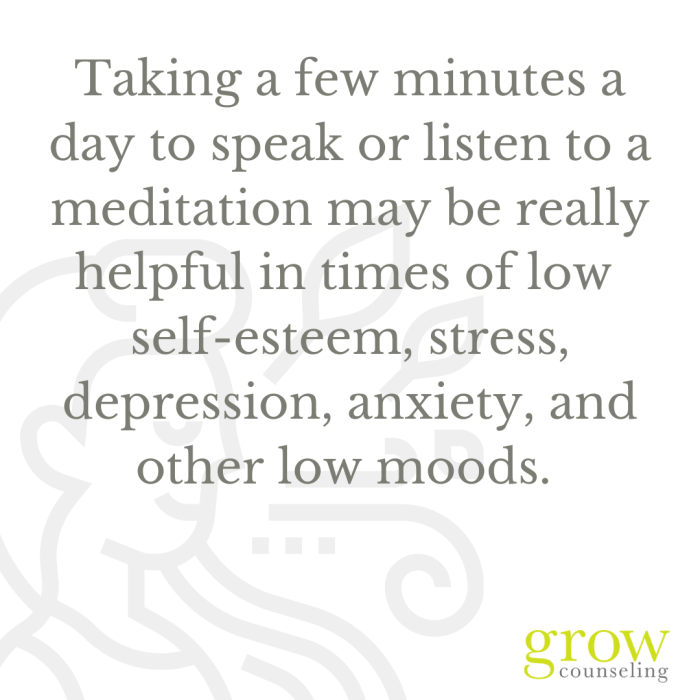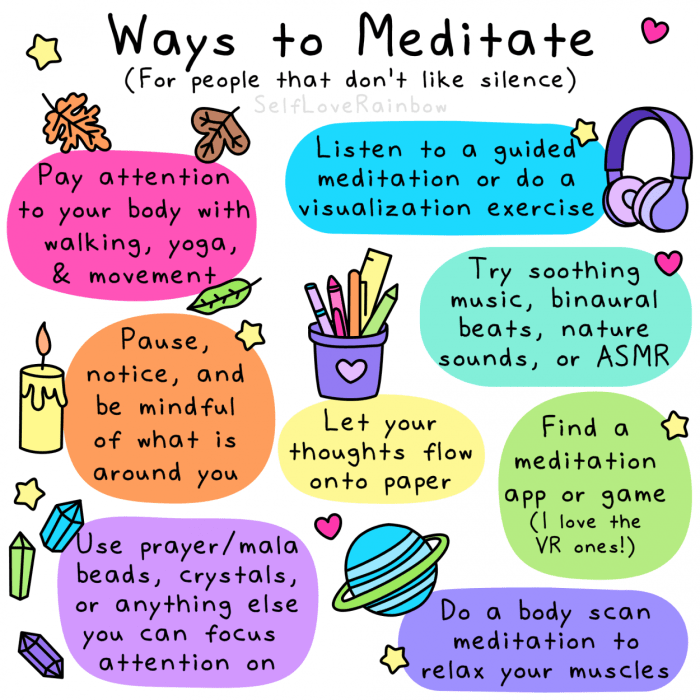How to Meditate for Practicing Self-Love and Acceptance sets the stage for this enthralling narrative, offering readers a glimpse into a story that is rich in detail with humor with funny tone style and brimming with originality from the outset.
Embark on a journey of self-discovery and love as we delve into the art of meditation for cultivating self-compassion and acceptance.
Introduction to Meditation for Self-Love and Acceptance

Meditation is a powerful tool for cultivating self-love and acceptance. By taking the time to quiet the mind and focus inward, individuals can develop a deeper sense of compassion and understanding towards themselves. This practice allows individuals to let go of self-criticism and negative thoughts, leading to a more positive self-image.
The Impact of Meditation on Mental Well-being
- Meditation helps individuals become more aware of their thoughts and emotions, enabling them to observe them without judgment.
- By practicing mindfulness through meditation, individuals can learn to respond to challenging situations with kindness and self-compassion.
- Regular meditation can reduce stress, anxiety, and depression, promoting overall mental well-being.
The Connection Between Mindfulness Practices and Self-Compassion
- Mindfulness practices, such as meditation, encourage individuals to be present in the moment and accept themselves as they are.
- Through mindfulness, individuals can develop a sense of empathy and kindness towards themselves, fostering self-love and acceptance.
- By cultivating self-compassion through meditation, individuals can build resilience and cope with difficulties in a more positive way.
Getting Started with Meditation

Meditation can be a powerful practice for cultivating self-love and acceptance. To begin your meditation journey, it’s important to create a conducive environment and establish a solid foundation for your practice.
Even while traveling, you can maintain your meditation practice with ease. Explore the 10 easy techniques provided in How to Meditate While Traveling: 10 Easy Techniques to stay grounded and centered amidst the chaos of the world.
Finding a Quiet and Comfortable Space, How to Meditate for Practicing Self-Love and Acceptance
Choose a quiet and peaceful space where you can relax without distractions. This could be a corner of your room, a cozy spot in your backyard, or any place where you feel calm and at ease.
When seeking clarity and focus in your daily life, meditation can be a powerful tool. Discover the 10 easy techniques outlined in How to Meditate for Clarity and Focus: 10 Easy Techniques to sharpen your mind and enhance your productivity.
- Ensure that the space is clean and clutter-free to help create a sense of tranquility.
- Consider adding elements like candles, cushions, or essential oils to enhance the atmosphere and make it more inviting.
Posture and Breathing Techniques for Beginners
Proper posture and breathing are essential components of a successful meditation practice. Here are some tips for beginners:
- Find a comfortable sitting position, either cross-legged on the floor or in a chair with your feet flat on the ground.
- Keep your back straight but not stiff, allowing for natural alignment of the spine.
- Rest your hands on your knees or in your lap, palms facing up or down, whichever feels more natural to you.
- Close your eyes or gaze softly at a spot in front of you to minimize distractions.
- Take slow, deep breaths, focusing on the sensation of the breath entering and leaving your body.
Setting Intentions Before Meditation
Before you begin your meditation practice, take a moment to set intentions for your session. Setting intentions can help you focus your mind and cultivate a sense of purpose in your practice.
As you embark on a journey to attract abundance and positivity into your life, mastering the art of meditation is key. Learn the techniques and practices in How to Meditate to Attract Abundance and Positivity to manifest your desires with the power of your mind.
Consider what you hope to achieve through meditation, whether it’s finding inner peace, increasing self-love, or fostering acceptance and compassion towards yourself.
Incorporating Self-Love and Acceptance in Meditation Practice: How To Meditate For Practicing Self-Love And Acceptance

When practicing meditation for self-love and acceptance, it is essential to create a nurturing and compassionate space within yourself. By focusing on positive affirmations and mantras, you can cultivate a mindset of self-compassion and acceptance.
Guided Meditation Techniques for Self-Compassion
Guided meditation techniques can help you direct your thoughts and emotions towards self-compassion. Here are some techniques to incorporate in your meditation practice:
- Begin by focusing on your breath and taking deep, calming breaths to center yourself.
- Visualize a warm, loving light surrounding you, filling you with feelings of love and acceptance.
- Repeat affirmations such as “I am worthy of love and acceptance” or “I am enough just as I am” to reinforce positive self-talk.
- Imagine sending love and compassion to yourself, embracing all parts of who you are without judgment.
Benefits of Affirmations and Mantras
Affirmations and mantras play a crucial role in cultivating self-love and acceptance during meditation. They can help rewire negative thought patterns and promote a mindset of self-compassion. Here are some benefits of using affirmations and mantras:
- Boost self-esteem and self-confidence by reinforcing positive beliefs about yourself.
- Reduce stress and anxiety by shifting your focus towards self-compassion and acceptance.
- Improve overall well-being and mental health by fostering a kind and loving relationship with yourself.
- Enhance self-awareness and mindfulness by grounding yourself in the present moment with positive affirmations.
Overcoming Challenges in Practicing Self-Love Through Meditation

Practicing self-love through meditation can be a transformative experience, but it is not without its challenges. It is essential to address these obstacles to fully reap the benefits of self-love and acceptance in your meditation practice.
Dealing with Distractions and Negative Thoughts
- Acknowledge distractions and negative thoughts without judgment. Simply observe them and let them pass without getting attached to them.
- Redirect your focus back to your breath or mantra whenever distractions arise. Consistent practice will help strengthen your ability to stay present.
- Affirmations can be powerful tools to counter negative thoughts. Repeat positive affirmations to yourself during meditation to cultivate self-love and acceptance.
The Importance of Self-Forgiveness and Patience
- Practice self-compassion by forgiving yourself for past mistakes and letting go of any guilt or shame. Remember that you are only human, and it is okay to make mistakes.
- Be patient with yourself as you navigate your meditation practice. Self-love is a journey, and it takes time to develop a deeper sense of love and acceptance for yourself.
- Celebrate small victories and progress along the way. Recognize the effort you put into your meditation practice and acknowledge the growth you experience in self-love.
As we conclude this exploration of meditation for self-love and acceptance, remember that the power to love and accept yourself lies within your own practice. Embrace each moment with kindness and compassion.